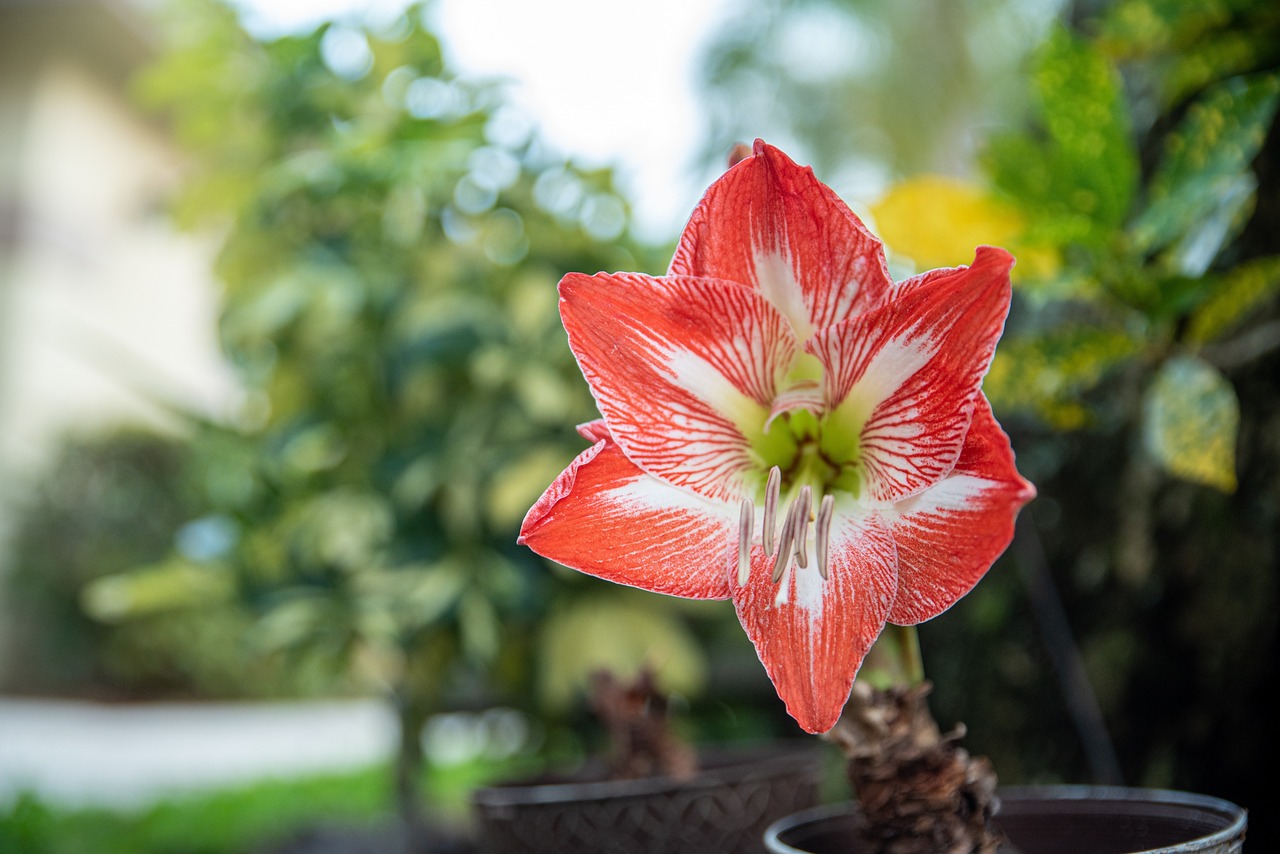When it comes to gardening, choosing the right plants can be as much about aesthetics as it is about sustainability and resilience. One particularly stunning flower that has captured the hearts of gardeners around the world is the Amaryllis. Known for its spectacular blooms and array of vibrant colors, this plant brings joy and elegance to any garden or indoor space.
However, many gardeners face a common challenge: deer. These charming yet destructive creatures can wreak havoc on our beloved plants, leaving us to wonder—are Amaryllis deer resistant?
Are Amaryllis Deer Resistant?

What Does “Deer Resistant” Mean?
Deer resistant plants possess certain characteristics that make them less appealing to deer. These can include strong scents, bitter tastes, or tough foliage. It’s important to note that “deer resistant” does not mean “deer proof.” During periods of food scarcity or high deer populations, these creatures may still nibble on so-called resistant plants.
Amaryllis and Deer

Amaryllis’ resistance to deer can be attributed to its toxic properties. Specifically, the bulbs contain compounds that are harmful when ingested. These toxic traits make them less attractive to deer, who typically avoid plants that can make them sick.
Several studies and anecdotal evidence suggest that while deer might occasionally munch on Amaryllis, they are generally not a preferred food source compared to other garden plants. Many gardeners report minimal to no damage to their Amaryllis plants despite the presence of deer in their area.
Factors Affecting Deer Behavior

Despite Amaryllis having certain deer-resistant qualities, the behavior of deer can be unpredictable. Several factors can influence whether deer will choose to eat Amaryllis:
Availability of Other Food Sources
Deer are opportunistic feeders. In times of scarcity, or during harsh winters, they may be compelled to approach non-preferred plants, including Amaryllis. If your garden is rich with more enticing flora, the desire for Amaryllis will likely diminish.
Season and Hunger Levels
During the late summer and early fall, deer may be less likely to encroach upon gardens due to the abundance of natural food sources. However, during winter months, when their options are limited, they might turn to plants they would otherwise avoid.
Surrounding Habitat
Gardens located in rural or forested areas may see more deer activity. Conversely, areas that are less dense with deer populations could experience fewer visits. Also, gardens that are adjacent to deer trails or wooded areas may be more susceptible to deer challenges.
Strategies to Deter Deer

While Amaryllis has some natural deer resistance, there are several additional strategies to protect these beautiful plants and other garden favorites from deer.
1. Plant Companions
Including other deer-resistant plants in your garden can help create a barrier or mask the scent of Amaryllis. Plants like lavender, rosemary, and sage not only offer resistance but also contribute to a fragrant and colorful garden.
2. Physical Barriers
Installing deer fences is a long-term solution for preventing access. The fence should ideally be at least 8 feet tall to deter even the most athletic deer. Temporary barriers like netting or row covers can also protect plants during vulnerable times.
3. Deer Repellents
There are various commercial deer repellents available on the market. These products often contain unpleasant scents or tastes that deter deer from munching on your garden plants. Alternatively, homemade solutions using ingredients like garlic, castor oil, or hot peppers can be effective.
4. Motion-Activated Devices
Devices that emit noise or spray water when they detect movement can effectively scare deer away. Utilizing motion-activated sprinklers or noise-making devices can create an unexpected environment for deer, making them hesitant to approach your garden.
5. Scare Tactics
Incorporating scare tactics, like reflective tape, scarecrows, or even noise-making wind chimes, can help deter deer. While these methods may require regular changes or updates to remain effective, they can disrupt deer behavior if implemented creatively.
6. Regular Plant Maintenance
Keeping your garden tidy can also help deter deer. Overgrown plants can provide cover for deer, allowing them to feel safe while they forage. Regularly trimming back foliage and removing excess debris can discourage deer from frequenting your garden.
The Benefits of Deer-Resistant Plants
Incorporating deer-resistant plants, such as Amaryllis, into your garden not only provides beauty but also brings several benefits:
1. Reduced Maintenance
Deer-resistant plants typically require less maintenance in terms of protection against browsing. This can save time and resources for gardeners, allowing them to enjoy a more carefree experience.
2. Biodiversity
Using a variety of native and deer-resistant plants can enhance biodiversity in your garden. This diversity can support local wildlife and pollinators, creating a healthier ecosystem overall.
3. Aesthetic Appeal
Deer-resistant plants can still be visually stunning. Amaryllis, with its large, colorful blooms, can be a focal point in your garden design while providing the added bonus of decreased deer activity.
4. Seasonal Interest
By mixing Amaryllis with other plants that bloom in different seasons, you can create a garden that offers visual interest year-round. This variety can improve your enjoyment of the space and enhance its overall look.
Caring for Your Amaryllis
Even if deer are less likely to target your Amaryllis, proper care is crucial to ensure they thrive and produce stunning blooms:
1. Planting
When planting Amaryllis bulbs, choose a container with good drainage and a quality potting mix. Plant the bulb with the top third exposed to facilitate healthy growth. If planting outdoors, select a location with well-draining soil and adequate sunlight.
2. Watering
Monitor soil moisture closely. Overwatering can lead to rot, while underwatering can stress the plant. A general rule is to water when the top inch of the soil feels dry to the touch. During the growing season, keep the moisture consistent, but reduce watering once the plant goes dormant after blooming.
3. Fertilization
Using a balanced fertilizer can enhance growth and blooming. Feed your Amaryllis every 4-6 weeks during the growing season with a diluted liquid fertilizer or a slow-release formula. Avoid fertilizing during dormancy.
4. Dormancy
After blooming, allow the foliage to die back naturally. This process replenishes the bulb for the next season’s growth. Store the bulbs in a cool, dry place if you plant them indoors.
Conclusion
In summary, Amaryllis is generally considered deer resistant due to its toxic properties, which deter these herbivores from making it a primary food source. However, the unpredictable behavior of deer means that they may occasionally nibble on these stunning flowers, especially if food sources are limited.
By adopting various deterrence strategies, such as planting companions, using repellents, and employing physical barriers, you can help protect your Amaryllis and your garden as a whole. Embracing deer-resistant plants offers an array of benefits, including reduced maintenance and enhanced biodiversity.
With proper care and diligence, your Amaryllis can flourish despite deer presence, allowing you to enjoy their breathtaking blooms for many seasons to come. Whether in pots indoors or thriving in your outdoor landscape, these beautiful flowers can add vibrancy to your life, helping you create a garden space that is both delightful to behold and resilient against challenges posed by deer and other garden pests.
Ultimately, gardening is a rewarding experience filled with both challenges and triumphs. Understanding the nuances of the plants you choose, like our stunning Amaryllis, empowers you to create a luscious, resilient garden sanctuary that attracts not only the admiration of passersby but also the harmony of nature





